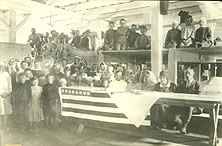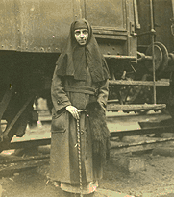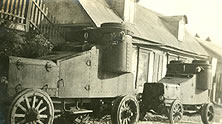A Selection of Vashti Bartlett's Siberian
Photographs and Other Documents
I returned to Vladivostok and came here
just in time to help with the Revolution. —V.B.
Unless otherwise noted, the italicized captions
below are the (typed) captions from Vashti Bartlett's photograph
album.
Click on images for larger versions

Municipal Barracks at Tomsk taken over by the American
Red Cross for housing refugees. Families are limited to a floor
space of about eight feet square. To increase the number of
inmates accomodated the high roofed barracks are divided in
tiers.

Countess Tolstoi, Russian Red
Cross [worker] who
identified the remains of the Czar and Czarina, confirming the
rumor of their execution in Ekaterinburg. She herself was condemned
to death and was shot in the foot while making her escape.

Babuska [sic]
(Catherine Breshkovsky) Grandmother
of the Russian Revolution.
Photo taken at Vladivostok.

General Gaida, famous Czech officer who
served in the Siberian Army and later led an insurrection
at Vladivostok, Nov. 17-18, 1919.
Document Posted on the Bulletin Board of the American Red Cross,
Nov. 19, 1919.
"Summary of Events of Attempted Revolution
in Vladivostok. Page1, page
2
American gondola car converted into an armored
car for special use of the Kolchak army, on the Trans-Siberian
R.R.
 Armored autos opposite house of General Rosonoff.
Armored autos opposite house of General Rosonoff.
|

Siberian soldiers carrying soup kettle.

A memento from Russian travel.
|
Children In Transit
When the Bolshevik revolution began in Petrograd (St. Petersburg)
some 1000 children were evacuated from that city. They were
placed by their parents on the Trans-Siberian railroad in the
hopes they would reach safety in Siberia. They traveled for
two weeks, over 1500 miles, finally arriving at the terminus
of the railway, in Vladivostok, where the Red Cross workers
took them under their wing.
|
Diary entry, Dec. 8, 1919
Yesterday I went to Russian Island...the children gave a
very creditable show and in the evening they danced the Russian
dances...—V.B.
 .
A hand-painted scene on the cover of a dance program given by
the Petrograd Children's Colony, on Russian Island, December 7,
1919.

This elaborately costumed figure (rendered in watercolor), appears
on a second program cover for the Petrograd Children's Colony's,
the same performance as the one noted above, December 7, 1919.
From the American Red Cross newsletter (Feb. 1920): "We
gave toys and presents to our own little protégées
in the Petrograd Children's Colony on Russian Island."
|
|